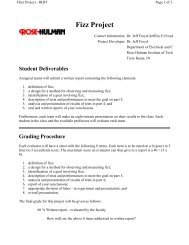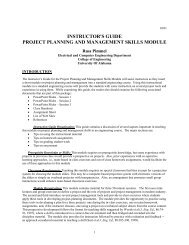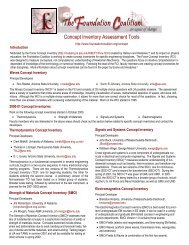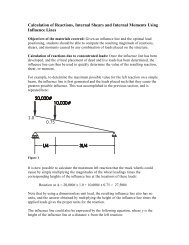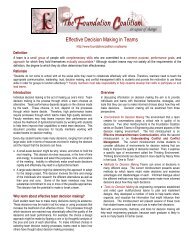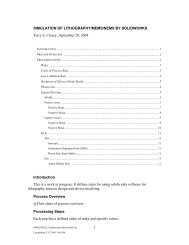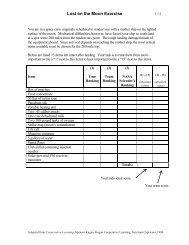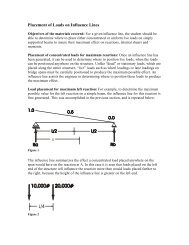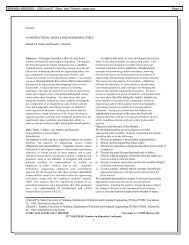stress transformation and mohr's circle - Foundation Coalition
stress transformation and mohr's circle - Foundation Coalition
stress transformation and mohr's circle - Foundation Coalition
Create successful ePaper yourself
Turn your PDF publications into a flip-book with our unique Google optimized e-Paper software.
108 CHAPTER 5. STRESS TRANSFORMATION AND MOHR’S CIRCLE<br />
For the above case the unit outer normal vector n, isgiven by<br />
n = cos θi + sin θj (5.1)<br />
Therefore, application of Cauchy’s formula (t (n) = n·σ) results in the following components for t (n)<br />
(the <strong>stress</strong> tensor is assumed to be symmetric <strong>and</strong> therefore σyx = σxy):<br />
t (n)x = σxx cos θ + σyx sin θ<br />
t (n)y = σxy cos θ + σyy sin θ (5.2)<br />
t (n)z = 0<br />
However, these components are of no particular physical interest since they are neither normal nor<br />
parallel to the plane defined by n. The components of t (n) that are normal <strong>and</strong> parallel to the plane<br />
defined by n can be easily obtained through vector calculus. Note that the unit normal n <strong>and</strong> the<br />
x ′ -axis have the same direction. The component of t (n) normal to the plane is thus σx ′ x ′ <strong>and</strong> is<br />
given by the dot product of t (n) with n (note: first substitute σyx = σxy in t (n)x ):<br />
σx ′ x ′ = t (n) · n = ((σxx cos θ + σxy sin θ)i +(σxy cos θ + σyy sin θ)j) · (cos θi + sin θj) (5.3)<br />
= σxx cos 2 θ +2σxy sin θ cos θ + σyy sin 2 θ<br />
where the x ′ -y ′ axes are rotated counterclockwise from the x-axes by the angle θ.<br />
Since the x ′ axis is in the direction of n, σx ′ x ′ (<strong>stress</strong> normal to plane with unit normal n) is<br />
often denoted as σn. Equations 5.2 <strong>and</strong> 5.3 can also be combined by writing t (n) = n · σ <strong>and</strong><br />
σn = σx ′ x ′ = t (n) · n so that we have the following vector <strong>and</strong> matrix result:<br />
σn = σx ′ x ′ = n · σ · n =<br />
(1×2) (2×2) (2×1)<br />
[n]<br />
[σ]<br />
[n] (5.4)<br />
In order to obtain the component of t (n) parallel to the plane defined by n, itisfirst convenient to<br />
define the unit normal in the y ′ direction, denoted n ′ ,asfollows:<br />
n ′ = k × n = − sin θi + cos θj (5.5)<br />
The projection of t (n) on the plane n is found by taking the dot product of t (n) with n ′ ,thus yielding<br />
the shear <strong>stress</strong> component σx ′ y ′,<br />
σx ′ y ′ = t (n) · n ′ =⇒ (5.6)<br />
σx ′ y ′ = −(σxx − σyy) sin θ cos θ + σxy(cos 2 θ − sin 2 θ)<br />
In the same manner, σy ′ y ′ <strong>and</strong> σy ′ x ′ can be determined (note: this step is not necessary):<br />
σy ′ y ′ = t (n ′ ) · n ′ =⇒<br />
σy ′ y ′ = [−(−σxx sin θ + σxy cos θ) sin θ +(−σyx sin θ + σyy cos θ) cos θ]<br />
σy ′ x ′ = t (n ′ ) · n =⇒<br />
σy ′ x ′ = [(−σxx sin θ + σxy cos θ) cos θ +(−σyx sin θ + σyy cos θ) sin θ]<br />
Equations 5.3 <strong>and</strong> 5.6 can now be used to obtain the normal <strong>stress</strong>, σx ′ x ′, <strong>and</strong> shear <strong>stress</strong>, σx ′ y ′,on<br />
a plane defined by the angle θ (measured CCW from x-axis), given σxx, σyy <strong>and</strong> σxy:<br />
Stress Transformation from x-y to x ′ -y ′ Coordinates<br />
σx ′ x ′ = σxx cos 2 θ +2σxy sin θ cos θ + σyy sin 2 θ (5.7)<br />
σx ′ y ′ = −(σxx − σyy) sin θ cos θ + σxy(cos 2 θ − sin 2 θ)




